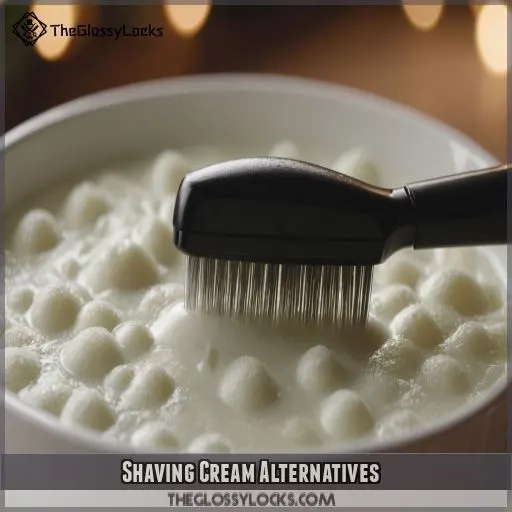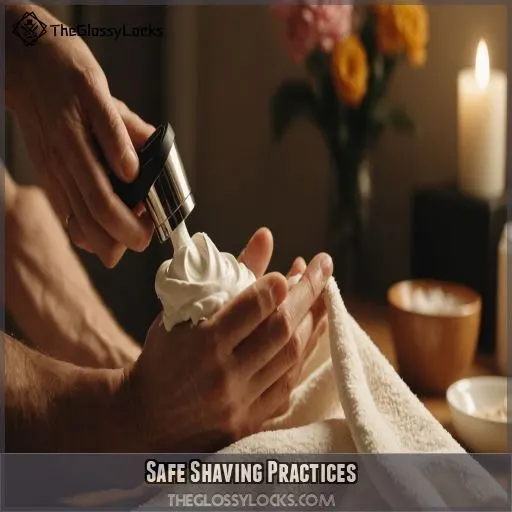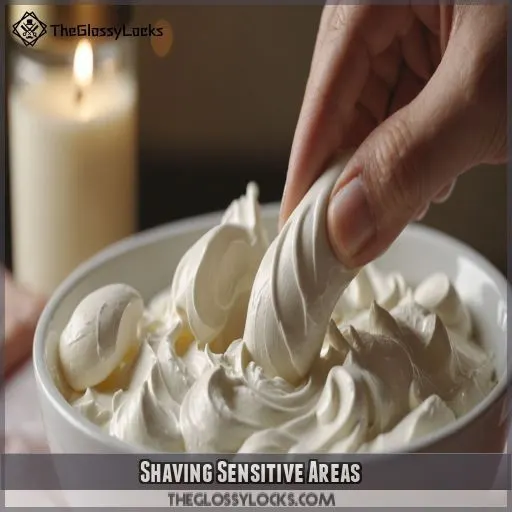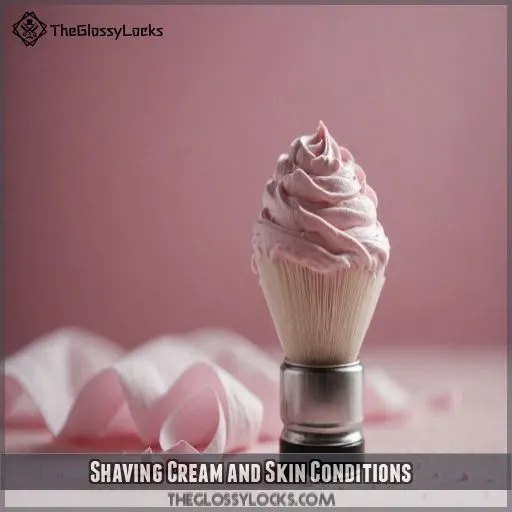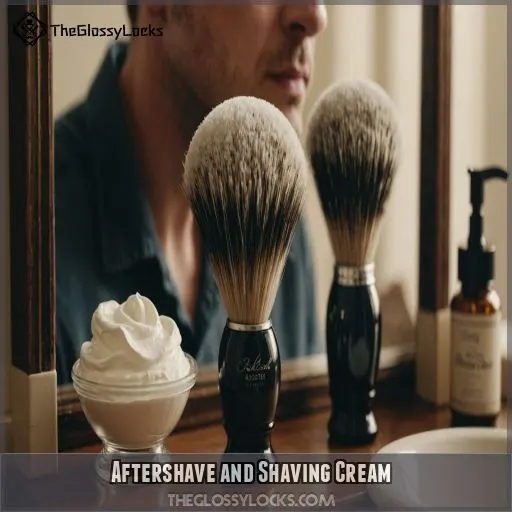This site is supported by our readers. We may earn a commission, at no cost to you, if you purchase through links.
 You’re not alone in the struggle of shaving sensitive areas.
You’re not alone in the struggle of shaving sensitive areas.
When it comes to shaving sensitive areas, you need a gentle and effective strategy to avoid irritation, ingrown hairs, and razor burn.
Start by choosing a shaving cream or alternative that’s specifically designed for sensitive skin, featuring soothing ingredients like aloe vera or coconut oil.
Apply a small amount, massaging it onto the skin to help the razor glide smoothly.
Shave in the direction of hair growth, and don’t forget to moisturize afterwards.
Ready to master the art of shaving sensitive areas?
Table Of Contents
- Key Takeaways
- Choosing the Right Shaving Cream
- Shaving Cream Alternatives
- Safe Shaving Practices
- Shaving Sensitive Areas
- Shaving Cream and Skin Conditions
- Aftershave and Shaving Cream
- Tips for a Smooth Shave
- Frequently Asked Questions (FAQs)
- Can you use shaving cream on intimate areas?
- Can I use magic shave cream on my pubic area?
- What is the best shaving cream for shaving pubic area?
- Can I use shaving cream as lube?
- How often should I shave sensitive areas to avoid irritation?
- Can I use shaving cream on sunburned or damaged skin?
- What are the benefits of using a shaving brush on sensitive areas?
- Are there any specific shaving techniques for sensitive skin types?
- Can I use a combination of shaving cream alternatives at once?
- Conclusion
Key Takeaways
- You’re not alone in the struggle of shaving sensitive areas, so it’s time to master the art of shaving cream application to avoid irritation, ingrown hairs, and razor burn – your skin will thank you!
- When it comes to shaving sensitive areas, choose a gentle shaving cream or alternative that’s specifically designed for sensitive skin, featuring soothing ingredients like aloe vera or coconut oil. Apply a small amount and massage it onto the skin to help the razor glide smoothly.
- To shave like a pro, exfoliate your skin before shaving to remove dead cells and help the razor glide smoothly. Use a sharp razor blade to reduce irritation and ingrown hairs, and shave in a well-lit area to avoid nicks and cuts.
- After shaving, rinse with warm water to remove any remaining hair and shaving cream. Then, moisturize with a gentle, fragrance-free lotion to soothe sensitive skin. Don’t forget to store your shaving cream properly to keep it fresh and effective.
Choosing the Right Shaving Cream
You’re on a mission to find the perfect shaving cream for your sensitive skin – and we’re here to help. From identifying your skin type to picking the right ingredients, we’ll walk you through the process of choosing a shaving cream that will make your skin smile, not sting .
Identifying Sensitive Skin Types
Knowing your skin type is important to avoid shaving irritation. If you experience persistent redness, visible blood vessels, or pimples, you likely have sensitive skin. Time to adjust your skin care routine and shaving cream choice!
Key Ingredients for Sensitive Skin
When choosing a shaving cream for sensitive skin, look for ingredients like aloe vera, glycerin, and hyaluronic acid, which provide soothing hydration. Chamomile extract and vitamin E can also help calm and protect your skin.
Avoiding Irritating Ingredients
When choosing a shaving cream for sensitive areas, be a label detective! Steer clear of parabens, harsh fragrances, alcohol, and artificial dyes, which can wreak havoc on your skin. Opt for gentle, fragrance-free options instead.
Shaving Cream Alternatives
If you’re shaving sensitive areas, you may find that traditional shaving creams just don’t cut it – literally. Luckily, there are some creative alternatives like baby oil, coconut oil, hair conditioner, and lotion that can provide a smoother, more comfortable shaving experience.
Using Baby Oil for Shaving
Now that you’ve chosen the right shaving cream, let’s explore alternatives like baby oil for shaving. Here are three benefits:
- Hydrates the skin: Baby oil creates a protective layer, preventing water loss.
- Gentle on skin: It’s hypoallergenic and free of harsh chemicals like parabens.
- Soothes razor burn: Baby oil can calm irritated skin, making it perfect for sensitive areas.
Coconut Oil for Sensitive Areas
When using coconut oil for sensitive areas, remember its benefits – anti-microbial, anti-inflammatory, and antioxidant properties – but also be aware of potential skin reactions and clogged pores.
Hair Conditioner as a Shaving Aid
Using hair conditioner as a shaving aid can be a game-changer for sensitive areas! It softens body hair, provides hydration, and reduces friction for a smoother shave.
Lotion for Shaving Sensitive Skin
- Use a fragrance-free lotion to minimize irritation
- Opt for a rich, non-greasy lotion for smooth shaving
- Apply a small amount, just enough to cover the area
Safe Shaving Practices
As you get ready to shave those sensitive areas, you want to make sure you’re doing it safely to avoid irritation, razor burn, and ingrown hairs.
Pre-Shaving Preparation
Before you shave, prep your skin with a 15-minute soak in warm water to soften hair and open pores, making it easier to tackle those sensitive areas.
Applying Shaving Cream or Alternatives
When applying shaving cream or alternatives, gently massage a small amount onto your skin, making sure to cover the entire area evenly for a smooth, razor-burn-free shave.
Shaving in the Direction of Hair Growth
When shaving, go with the flow – literally! Shave in the direction of hair growth to avoid ingrown hairs, razor burn, and irritation on sensitive areas.
Rinsing and Moisturizing After Shaving
After shaving, rinse with warm water to remove any remaining hair and shaving cream, then moisturize with a gentle, fragrance-free lotion to soothe sensitive skin.
- Here are some tips to make the most out of your post-shave routine:
- Use a moisturizer that suits your skin type, whether it’s a rich body butter or a lightweight, oil-free gel.
- Apply moisturizer while skin is still damp to lock in hydration and reduce irritation.
- Gently pat dry with a towel instead of rubbing vigorously to prevent friction and irritation.
- Consider using a moisturizer with soothing ingredients like aloe vera or chamomile to calm sensitive skin.
Shaving Sensitive Areas
You’re about to tackle the tricky task of shaving sensitive areas – don’t worry, we’ve got expert tips to help you navigate this delicate terrain. From choosing the right shaving cream to avoiding ingrown hairs and razor burn, we’ll guide you through the process with care and precision.
Shaving Intimate Areas Safely
When shaving intimate areas, prioritize gentle care. Opt for shaving cream alternatives like baby oil or aloe gel, and consider a pubic hair trimmer for added safety and comfort.
Using Shaving Cream on Sensitive Spots
When shaving sensitive spots, choose a gentle shaving cream or alternative like aloe gel or baby oil, and apply a thin layer to avoid irritation.
Avoiding Ingrown Hairs and Razor Burn
To avoid ingrown hairs and razor burn, exfoliate your skin before shaving, maintain good razor technique, and prioritize skin hydration and post-shave care for a smoother experience.
Shaving Cream for Pubic Area
When shaving the pubic area, prioritize gentle care. Here are 4 expert tips to help you shave with confidence:
- Exfoliate beforehand: Remove dead skin cells to prevent ingrown hairs.
- Choose the right shaving cream: Opt for fragrance-free and hypoallergenic products.
- Shave in the direction of hair growth: Reduce razor bumps and irritation.
- Moisturize after shaving: Soothe and hydrate your sensitive skin.
Shaving Cream and Skin Conditions
When you shave, you’ll want to take extra care if you have a skin condition like acne, rosacea, or excessive dryness. Don’t worry, with the right shaving cream and techniques, you can achieve a smooth shave without irritating your skin – and we’re here to show you how.
Shaving With Acne-Prone Skin
Shaving with acne-prone skin? Be gentle! Use a shaving cream with hyaluronic acid and stearic acid, and avoid tight clothes to reduce razor bumps and ingrown hairs.
Rosacea and Shaving Cream
When you have rosacea, shaving can be a minefield. Choose shaving creams with soothing ingredients like aloe vera or green tea to help calm your skin.
Managing Excessive Dryness
Managing excessive dryness requires a solid skin care routine, especially during winter shaving. Use rich moisturizers to boost hydration and consider a humidifier to combat dry air.
Photosensitivity and Shaving
When you have photosensitive skin, shaving can be a bit tricky. You’ll want to take extra precautions to avoid sunburn and irritation, especially in sensitive areas.
- Use a shaving cream with SPF to protect your skin from the sun’s harsh rays
- Apply a broad-spectrum sunscreen with at least SPF 30 after shaving
- Consider shaving in the evening to minimize sun exposure after hair removal
Aftershave and Shaving Cream
If you’re shaving sensitive areas, you’re probably trying to get the job done quickly and painlessly – but don’t forget about the importance of aftershave in keeping your skin healthy and happy. By choosing the right aftershave and using it correctly, you can reduce irritation, prevent ingrown hairs, and keep your skin feeling smooth and refreshed.
Benefits of Using Aftershave
Using aftershave can be a total game-changer! It helps with skin hydration, razor burn prevention, and soothing irritated skin, leaving you feeling fresh and confident.
Choosing the Right Aftershave
Now that you know the benefits of aftershave, let’s pick the perfect one for you. Consider these must-haves:
- Soothing ingredients like aloe vera or witch hazel for sensitive skin
- Moisturizing properties to combat dryness and irritation
- Acne-friendly formulas to prevent breakouts and ingrown hairs
Can I Use Shaving Cream as Lube?
Sorry to break it to you, but shaving cream doesn’t make a great lube – it can cause skin irritation and friction, especially on sensitive skin.
Alternatives to Aftershave
Consider DIY aftershave alternatives like aloe vera, witch hazel, or tea tree oil for a natural, gentle finish. These substitutes offer similar benefits without harsh ingredients.
Tips for a Smooth Shave
You’re about to tackle the sensitive areas – literally! To make sure you get a smooth shave, follow these expert tips that will guide you through the process with ease, making you a pro at shaving those tricky spots in no time.
Exfoliating Before Shaving
Before shaving, gently exfoliate your skin to remove dead cells and help the razor glide smoothly. This simple step can make a big difference in your shave.
Here are some tips to keep in mind:
- Choose the right tool: Use a gentle exfoliating glove, a soft washcloth, or a chemical exfoliant containing alpha-hydroxy acids (AHAs) or beta-hydroxy acids (BHAs).
- Select the right scrub: Opt for a gentle scrub containing small, round beads or a sugar or salt scrub for sensitive skin.
- Reap the benefits: Exfoliating can help prevent ingrown hairs, reduce razor burn, and leave your skin feeling smooth and refreshed.
- Time it right: Exfoliate 1-2 times a week, depending on your skin type, and avoid exfoliating too close to your shave to prevent irritation.
Using a Sharp Razor Blade
Now that you’ve exfoliated, grab a sharp razor blade to glide smoothly over your skin, reducing irritation and ingrown hairs – your skin will thank you!
Shaving in a Well-Lit Area
Now that you’ve grabbed a fresh blade, it’s time to talk lighting. This might sound obvious, but it’s really important for a smooth shave:
- Avoid razor accidents: Good lighting makes sure you can see every detail and avoid nicks and cuts. No one wants a shaving accident, especially in sensitive areas.
- No shadow problems: Shadows can cause visibility issues, so make sure your space is well-lit to avoid any shadow-related mishaps.
- See every detail: Proper lighting lets you spot those tricky spots and helps you get a close, precise shave.
Storing Shaving Cream Properly
Now that you’ve mastered shaving in a well-lit area, store your shaving cream properly by keeping it in a cool, dry place, away from direct sunlight and humidity.
Frequently Asked Questions (FAQs)
Can you use shaving cream on intimate areas?
You can use shaving cream on intimate areas, but choose a gentle, fragrance-free, and hypoallergenic option to minimize irritation . Opt for a shaving cream specifically designed for sensitive skin and intimate areas .
Can I use magic shave cream on my pubic area?
When in Rome, do as the Romans do" – with caution! Using magic shave cream on your pubic area might seem like a good idea, but it’s best to exercise caution and opt for gentle, fragrance-free alternatives instead.
What is the best shaving cream for shaving pubic area?
When shaving your pubic area, opt for a gentle, fragrance-free shaving cream specifically designed for sensitive skin. Look for ingredients like aloe vera, glycerin, or hyaluronic acid to help soothe and hydrate the skin.
Can I use shaving cream as lube?
Smoothly shaving sensitive spots requires savvy solutions. While shaving cream can provide a slippery surface, it’s not a suitable substitute for lubricant. Instead, explore alternative options like aloe gel or baby oil for a more comfortable experience.
How often should I shave sensitive areas to avoid irritation?
To avoid irritation, shave sensitive areas only when necessary, ideally every 4-7 days. Shaving too frequently can cause razor burn, ingrown hairs, and irritation, so give your skin time to heal and recover between sessions.
Can I use shaving cream on sunburned or damaged skin?
Sunburned skin is like an open wound, so it’s best to avoid shaving and give it time to heal. While shaving cream might provide some relief, it’s not the best solution. Stick to gentle, moisturising products like aloe vera to soothe and cool the skin.
What are the benefits of using a shaving brush on sensitive areas?
Using a shaving brush on sensitive areas helps create a rich lather, softly exfoliates, and lifts hairs for a closer shave. It’s gentler than fingers, reduces irritation, and gives you more control over the shaving process.
Are there any specific shaving techniques for sensitive skin types?
You’re in luck! For sensitive skin types, try shaving in the direction of hair growth, using light strokes, and avoiding nicks and cuts. Exfoliate gently beforehand and moisturize afterwards to keep your skin happy and healthy.
Can I use a combination of shaving cream alternatives at once?
You can mix and match shaving cream alternatives, but be cautious not to overdo it. Combining aloe gel with coconut oil or baby oil can be beneficial, but start with small amounts to make sure you don’t irritate your skin.
Conclusion
Imagine the satisfaction of a silky-smooth shave, minus the redness and irritation.
By mastering the art of shaving cream application for sensitive areas, you’ll be on your way to a more comfortable and confident you.
Remember to choose the right shaving cream, shave in the direction of hair growth, and moisturize afterwards.
With these expert tips, you’ll be saying goodbye to razor burn and hello to radiant, healthy-looking skin.


